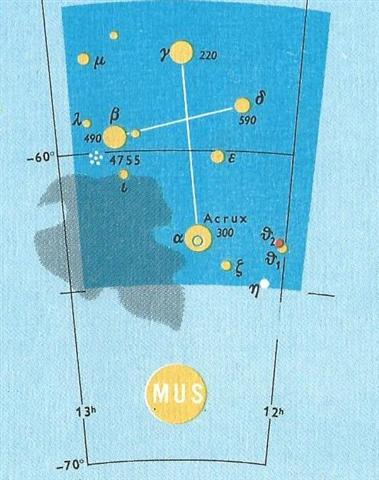I should update my star list with the remaining Greek lettered stars in Crux, because so far my list contains only 5 of them and according to Wikipedia there are also ι, κ, and λ, i.e. the constellation appears to have 5 + 3 = 8 Greek lettered stars:  However, in the star map of my astronomy book there is no κ star, but on the other hand there are also θ, η, ζ, and μ:
From the numbered stars of the cross we can count e.g.:
The Greek lettered stars thus seems to be 5 (already listed) + 7 = 12:
It is interesting to find that all these 12 stars are located between 12h and 13h, with the first star θ close to the Full Moon in March 19, where the figure in Cb14-9 makes a 'sweeping turn' with his left 'leg' - which together with his other curved limbs creates the impression of a swirling motion as in a vortex:
Beyond Gacrux (γ) there is a 4-night jump in time to the next Crucis star and we need to look at the beginning of side a to find the remaining 5 stars. ... In 1865 Kamakau recorded the Instructions in Ancient Hawaiian Astronomy as Taught by Kaneakahowaha, Astronomer, Seer, and Counselor of the Court of King Kamehameha I from which the following extract was taken: Take the lower part of a gourd or hula drum, rounded as a wheel (globe), on which several lines are to be marked and burned in, as described hereafter. These lines are called na alanui o na hoku hookele, the highways of the navigation stars, which stars are also called na hoku ai-aina, the stars which rule the land. Stars lying outside these three lines are called na hoku a ka lewa, foreign, strange, or outside stars. The first line is drawn from Hoku-paa, the fixed or North Star, to the most southerly star of Newe, the Southern Cross. (This hour circle coincides with the meridian on an evening in June, when it would divide the visible sky into halves.) The portion (of the sky) to the right or east of this line (the observer is evidently assumed to be facing north) is called ke ala ula a Kane, the dawning or bright road of Kane, and that to the left or west is called ke alanui maawe ula a Kanaloa, the much-traveled highway of Kanaloa. (Kane and Kanaloa were important gods in the Polynesian pantheon, Kane being associated with light, Kanaloa with darkness.) Then three lines are drawn east and west, one across the northern section indicates the northern limit of the Sun (corresponding with the Tropic of Cancer) about the 15th and 16th days of the month Kaulua (i.e., the 21st or 22nd of June) and is called ke alanui polohiwa a Kane, the black-shining road of Kane. The line across the southern section indicates the southern limit of the Sun about the 15th or 16th days of the month Hilinama (December 22) and is called ke alanui polohiwa a Kanaloa, the black-shining road of Kanaloa. The line exactly around the middle of the sphere is called ke alanui a ke ku'uku'u, the road of the spider, and also ke alanui i ka Piko a Wakea, the way to the navel of Wakea (the Sky-father). Between these lines are the fixed stars of the various lands, na hokupaa a ka aina. (These are the stars which hang suspended in the zeniths of the Polynesian islands most of which lie within the tropics.) On the sides are the stars by which one navigates ... | ||||||||||||||||||||||||||||||||||||||||||||||||||||||||||||||||||||||||||||||||||||||||||||||||||||||||||||||||||||||||||||||||||||








